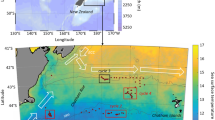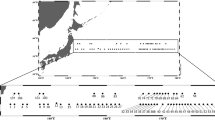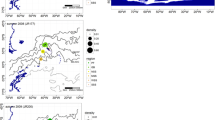Abstract
Distribution, density, and feeding dynamics of the pelagic tunicate Salpa thompsoni have been investigated during the expedition ANTARKTIS XVIII/5b to the Eastern Bellingshausen Sea on board RV Polarstern in April 2001. This expedition was the German contribution to the field campaign of the Southern Ocean Global Ocean Ecosystems Dynamics Study (SO-GLOBEC). Salps were found at 31% of all RMT-8 and Bongo stations. Their densities in the RMT-8 samples were low and did not exceed 4.8 ind m−2 and 7.4 mg C m−2. However, maximum salp densities sampled with the Bongo net reached 56 ind m−2 and 341 mg C m−2. A bimodal salp length frequency distribution was recorded over the shelf, and suggested two recent budding events. This was also confirmed by the developmental stage composition of solitary forms. Ingestion rates of aggregate forms increased from 2.8 to 13.9 μg (pig) ind−1 day−1 or from 0.25 to 2.38 mg C ind−1 day−1 in salps from 10 to 40 mm oral-atrial length, accounting for 25–75% of body carbon per day. Faecal pellet production rates were on average 0.08 pellet ind−1 h−1 with a pronounced diel pattern. Daily individual egestion rates in 13 and 30 mm aggregates ranged from 0.6 to 4.8 μg (pig) day−1 or from 164 to 239 μg C day−1. Assimilation efficiency ranged from 73 to 90% and from 65 to 76% in 13 and 30 mm aggregates, respectively. S. thompsoni exhibited similar ingestion and egestion rates previously estimated for low Antarctic (~50°S) habitats. It has been suggested that the salp population was able to develop in the Eastern Bellingshausen Sea due to an intrusion into the area of the warm Upper Circumpolar Deep Water









Similar content being viewed by others
References
Andersen V (1986) Effect of temperature on the filtration rate and percentage of assimilation of Salpa fusiformis Cuvier (Tunicata: Thaliacea). Hydrobiologia 137:135–140
Atkinson A, Siegel V, Pakhomov EA, Rothery P (2004) Long-term decline in krill stock and increase in salps within the Southern Ocean. Nature 432:100–103
Baars MA, Helling GR (1985) Methodological problems in the measurements of phytoplankton ingestion rate by gut fluorescence. Hydrobiol Bull 19:81–88
Bathmann U (ed) (2002) The expedition ANTARKTIS XVIII/5b of the research vessel “Polarstern” in 2001. Berichte Polar Meeresforsch 407:1–98
Bathmann U, Fischer G, Müller PJ, Gerdes D (1991) Short-term variations in particular matter sedimentation off Kapp Norvegia, Weddell Sea, Antarctica: relation to water mass advection, ice cover, plankton biomass and feeding activity. Polar Biol 11:185–195
Brichta M, Belem A (2002) Chlorophyll-a, particulate organic carbon/nitrogen (POC/N) and biogenic silica (Bsi) distribution. Berichte Polar Meeresforsch 407:61–64
von Bodungen B (1986) Phytoplankton growth and krill grazing during spring in the Bransfield Strait, Antarctica—implications from sediment trap collections. Polar Biol 6:153–160
Boysen-Ennen E, Piatkowski U (1988) Meso- and macrozooplankton communities in the Weddell Sea, Antarctica. Polar Biol 9:17–35
Casareto BE, Nemoto T (1986) Salps of the Southern ocean (Australian sector) during the 1983–84 summer, with special reference to the species Salpa thompsoni. Mem Natl Inst Polar Res 40:221–239
Casareto BE, Nemoto T (1987) Latitudinal variation of the number of muscle fibres in Sapla thompsoni (Tunicata, Thaliacea) in the Southern Ocean: implications for the validity of the species Salpa gerlachei. Proc NIPR Symp Polar Biol 1:90–104
Chiba S, Ishimaru T, Hosie GW, Wright SW (1999) Population structure change of Salpa thompsoni from austral mid-summer to autumn. Polar Biol 22:341–349
Chiba S, Ishimaru T, Hosie GW, Fukuchi M (2001) Spatio-temporal variability of zooplankton community structure off east Antarctica (90 to 160°E). Mar Ecol Prog Ser 216:95–108
Cisewski B, Strass V, van Franeker JA (2002) Underway measurements of currents with the vessel-mounted acoustic doppler current profiler. Berichte Polar Meeresforsch 407:16–18
Conover RJ, Durvasula R, Roy S, Wang R (1986) Probable loss of chlorophyll-derived pigments during passage through the gut of zooplankton and some of the consequences. Limnol Oceanogr 31:878–887
Daponte MC, Capitanio FL, Esnal GB (2001) A mechanism for swarming in the tunicate Salpa thompsoni (Foxton, 1961). Ant Sci 13:240–245
Deibel D (1982) Laboratory determined mortality, fecundity and growth rates of Thalia democratica Forskal and Dolioletta gegenbauri Uljianin (Tunicata, Thaliacea). J Plank Res 4:143–153
De la Mare WL (1997) Abrupt mid-twentieth-century decline in Antarctic sea-ice extent from whaling records. Nature 389:57–60
Drits AV, Semenova TN (1989) Trophic characteristics of major planktonic phytphages from South Shetland Islands region during early spring. In: Ponomareva LA (ed) Complex investigations of the pelagic zone of the Southern Ocean (in Russian). Shirshov Institute Oceanology Publishers, Moscow, pp 66–78
Dubischar CD, Bathmann UV (1997) Grazing impact of copepods and salps on phytoplankton in the Atlantic sector of the Southern Ocean. Deep Sea Res II 44:415–433
Dubischar C, Pakhomov EA, Bathmann UV (2005) The tunicate Salpa thompsoni ecology in the Southern Ocean. II. Proximate and elemental composition. Mar Biol (submitted)
Foxton P (1966) The distribution and life history of Salpa thompsoni Foxton with observations on a related species S. gerlachei Foxton. Discov Rep 34:1–116
Harbison GR, McAlister VL, Gilmer RW (1986) The response of the salp, Pegea confoederata, to high levels of particulate material: Starvation in the midst of plenty. Limnol Oceanogr 31:371–382
Hosie GW, Cochran TG, Pauly T, Beaumont KL, Wright SW, Kitchener JA (1997) Zooplankton community structure of Prydz bay, Antarctica, January–February 1993. Proc NIPR Symp Polar Biol 10:90–133
Hosie GW, Schultz MB, Kitchener JA, Cochran TG, Richards K (2000) Macrozooplankton community structure off East Antarctica (80–150°E) during the austral summer of 1995/1996. Deep Sea Res II 47:2437–2463
Huntley ME, Sykes PF, Marin V (1989) Biometry and trophodynamics of Salpa thompsoni Foxton (Tunicata: Thaliacea) near the Antarctic Peninsula in Austral summer, 1983–1984. Polar Biol 10:59–70
Klinck JM, Hofmann EE, Beardsley RC, Salihoglu B, Howard S (2004) Water-mass properties and circulation on the west Antarctic Peninsula continental shelf in austral fall and winter 2001. Deep Sea Res II 51:1925–1946
Le Fèvre J, Legendre L, Rivkin RB, (1998) Fluxes of biogenic carbon in the Southern Ocean: roles of large microphagous zooplankton. J Mar Syst 17:325–345
Levitus A, Antonov JI, Boyer TP, Stephens C (2000) Warming of the World Ocean. Science 287:2225–2229
Loeb V, Siegel V, Holm-Hansen O, Hewitt R, Fraser W, Trivelpiece W, Trivelpiece S (1997) Effects of sea-ice extent and krill or salp dominance on the Antarctic food web. Nature 387:897–900
Mackas D, Bohrer R (1976) Fluorescence analysis of zooplankton gut contents and an investigation of diel feeding patterns. J Exp Mar Biol Ecol 25:77–85
Madin LP, Deibel D (1998) Feeding and energetics of Thaliacea. In: Bone Q (ed) The biology of pelagic tunicates. Oxford University Press, Oxford, pp 81–104
Madin LP, Kremer R (1995) Determination of the filter-feeding rates of salps (Tunicata, Thaliacea). ICES J Mar Sci 52:583–595
Madin LP, Purcell JE (1992) Feeding, metabolism, and growth of Cyclosalpa bakeri in the subarctic Pacific. Limnol Oceanogr 37:1236–1251
Moline MA, Claustre H, Frazer TK, Grzymski J, Schofield O, Vernet M (2000) Changes in phytoplankton assemblages along the Antarctic Peninsula and potential implications for the Antarctic food web. In: Davison W, Howard-Williams C, Broady P (eds) Antarctic ecosystems: models for wider ecological understanding. The Caxon Press, Christchurch, pp 263–271
Nicol A, Pauly T, Bindoff NL, Wright S, Thlele D, Hosie GW, Strutton PG, Woehler E (2000) Ocean circulation off east Antarctica affects ecosystem structure and sea-ice extent. Nature 406:504–507
Nishikawa J, Tsuda A (2001) Diel vertical migration of the tunicate Salpa thompsoni in the Southern Ocean during summer. Polar Biol 24:299–302
Nishikawa J, Naganobu M, Ichii T, Ishii H, Terazaki M, Kawaguchi K (1995) Distribution of salps near the South Shetland Islands during austral summer, 1990–1991 with special reference to krill distribution. Polar Biol 15:31–39
Omori M, Ikeda T (1984) Methods in marine zooplankton ecology. Wiley, New York, 323pp
Pakhomov EA (1991) Antarctic macroplankton and the nutrition of coastal fishes (in Russian). PhD Thesis, P.P. Shirshov Institute of Oceanology, Russian Academy of Sciences, Moscow, pp 1–263
Pakhomov EA (2004) Salp/krill interactions in the eastern Atlantic sector of the Southern Ocean. Deep Sea Res II 51:2645–2660
Pakhomov EA, Froneman PW (2004) Mesozooplankton dynamics in the eastern Atlantic sector of the Southern Ocean during the austral summer 1997/1998. 2. Grazing impact. Deep Sea Res II 51:2617–2631
Pakhomov EA, Grachev DG, Trotsenko BG, (1994) Distribution and composition of macroplankton communities in the Lazarev Sea (Antarctic). Oceanology 33:635–642
Pakhomov EA, Froneman PW, Perissinotto R (2002) Salp/krill interactions in the Southern Ocean: spatial segregation and implications for the carbon flux. Deep Sea Res II 49:1881–1907
Pakhomov EA, Fuentes V, Schloss I, Atencio A, Esnal GB (2003) Beaching of the tunicate Salpa thompsoni at high levels of suspended particulate matter in the Southern Ocean. Polar Biol 26:427–431
Perissinotto R, Pakhomov EA (1998a) Contribution of salps to carbon flux of marginal ice zone of the Lazarev Sea, southern ocean. Mar Biol 131:25–32
Perissinotto R, Pakhomov EA (1998b) The trophic role of the tunicate Salpa thompsoni in the Antarctic marine ecosystem. J Mar Syst 17:361–374
Piatkowski U (1989) Macrozooplankton communities from Weddell Sea surface waters, Antarctica. Pesq Antárt Bras 1:1–10
Ross RM, Quetin LB, Haberman KL (1998) Interannual and seasonal variability in short-term grazing impact of Euphausia superba in nearshore and offshore waters west of the Antarctic Peninsula. J Mar Syst 17:261–273
Schnack SB (1985) A note on the sedimentation of particulate matter in Antarctic waters during summer. Meeresforschung 30:306–315
Siegel V, Harm U (1996) The composition, abundance, biomass and diversity of the epipelagic zooplankton communities of the southern Bellingshausen Sea (Antarctic) with special reference to krill and salps. Arch Fish Mar Res. 44:115–139
Smedsrud LH (2005) Warming of the deep water in the Weddell Sea along the Greenwich meridian: 1977–2001. Deep Sea Res I 52:241–258
Smith DA, Hofmann EE, Klinck JM, Lascara CM (1999) Hydrography and circulation of the West Antarctic Peninsula Continental Shelf. Deep Sea Res I 46:925–949
Strickland JDH, Parsons TR (1968) A practical handbook of seawater analysis. Bull Fish Res Bd Canada 167:1–311
Voronina NM (1998) Comparative abundance and distribution of major filter-feeders in the Antarctic pelagic zone. J Mar Syst 17:375–390
Walsh JJ, Dieterle DA, Lenes J (2001) A numerical analysis of carbon dynamics of the Southern Ocean phytoplankton community: the roles of light and grazing in effecting both sequestration of atmospheric CO2 and food availability to larval krill. Deep Sea Res I 48:1–48
Acknowledgements
We are grateful to the University of Fort Hare (South Africa), the Alfred Wegener Institute for Polar and Marine Research (Germany), the Alexander von Humboldt Foundation (Germany) and the University of British Columbia (Canada) for providing funds and facilities, which allowed conducting and completing this study. The professional and friendly support at sea by colleagues, the Captain and the crew of the RV Polarstern during the ANTATKTIS XVIII/5b cruise is greatly appreciated. B. Cisewski, H. Borth, B. Rabe, K. Rinas and C. Radke contributed to collecting the CTD data.
Author information
Authors and Affiliations
Corresponding author
Additional information
Communicated by O. Kinne, Oldendorf/Luhe
Rights and permissions
About this article
Cite this article
Pakhomov, E.A., Dubischar, C.D., Strass, V. et al. The tunicate Salpa thompsoni ecology in the Southern Ocean. I. Distribution, biomass, demography and feeding ecophysiology. Mar Biol 149, 609–623 (2006). https://doi.org/10.1007/s00227-005-0225-9
Received:
Accepted:
Published:
Issue Date:
DOI: https://doi.org/10.1007/s00227-005-0225-9




